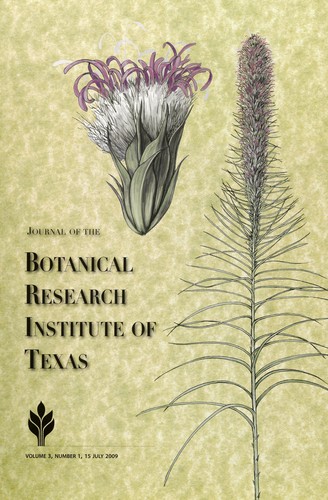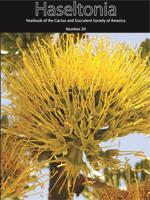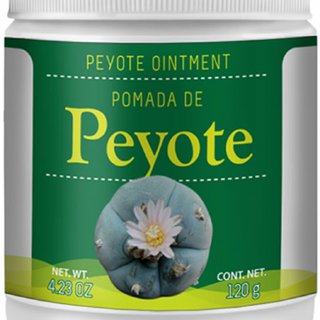
Biochemistry
Lophophora williamsii
West Texas
Peer-reviewed articles



Abstract
Lophophora williamsii, peyote, is a small cactus growing to approximately 10 cm in diameter with a flat to dome-shaped spineless crown with fissures or ribs that develop following the Fibonacci series and whose numbers indicate relative degree of maturing. In this study crown tissue of 30 wild-collected specimens was analyzed to determine whether there was a correlation between the concentration of the primary alkaloid mescaline in crown tissue with the average diameter of the crown. We also compared mescaline concentration in three groups of ten individuals: 5 ribs (juvenile stage), 8 ribs (intermediate), and 13 ribs (elder/mature stage), since these Fibonacci numbers are the most stable and long-lasting on L. williamsii. This was designed to test the hypothesis that there is a positive correlation between mescaline concentration and both diameter and rib number. Nine greenhouse-grown specimens were likewise analyzed to serve as a control group for the study. All 39 tissue samples were subjected to an alkaloid extraction procedure followed by an acid-base washing procedure. Mescaline was identified using liquid-chromatography and mass spectroscopy and then quantified using reverse-phase high-pressure liquid chromatography. The Pearson’s Chi-squared test showed no statistical correlation between increasing mescaline concentration and increasing rib numbers for field-collected samples and greenhouse?raised control samples. Field-collected samples: P-value of 0.392; greenhouse control samples: P-value of 0.313. Similarly, field and greenhouse samples showed no statistical correlation between mescaline concentration and average diameter of the crown. Field-collected samples: P-value of 0.251; greenhouse control samples: P-value of 0.229. This study contributes to the understanding of this vulnerable species and to approaches to its overall conservation and the preservation of Native American culture.


Abstract
We evaluated the pharmacological consequences of tissues other than crown being included with harvested peyote. Mean mescaline concentrations were determined for crown, non-chlorophyllous stem, and root, using mature individuals from the same population in South Texas. Samples of each tissue—crown, non-chlorophyllous stem, and root—were taken from each of 13 individual plants. Samples were dried, triturated, defatted, and extracted with methylene chloride, using an acid-base aqueous wash to recover the alkaloids. The concentration of mescaline in each sample was determined by HPLC. The average mescaline concentration in non-chlorophyllous stem was an order of magnitude lower than that in crown, whereas the mescaline concentration in root was two orders of magnitude lower than that in crown. These results show that non-chlorophyllous stem is a poor source of mescaline, and root is an extremely poor source. These results have important implications for conservation, suggesting that non-traditional harvesting of peyote for religious or medicinal use involving the cutting of non-chlorophyllous tissue are contributing to the death of plants and the subsequent failure to regenerate new crowns. Therefore, this practice should be reevaluated by peyote harvesters and users.



JOURNAL ARTICLE
A preliminary report of mescaline concentrations in small regrowth crowns vs. mature crowns of Lophophora williamsii (Cactaceae): Cultural, economic, and conservation implications.
Abul Kalam, Keeper Trout, Molly T. Klein, Paul Daley, Diana Hulsey and Martin Terry
Abstract
A phytochemical analytical study was conducted to address the question of whether the mescaline concentration in Lophophora williamsii (peyote) is dependent on the maturity and/or size of the plant. Samples of crown tissue (4 g each) biopsied from mature peyote cacti and whole small regrowth crowns (2-4 g each) were collected from the same population in the Tamaulipan Thornscrub ecoregion of South Texas. For each of the two groups (mature and small regrowth), the individual tissue samples were pooled, desiccated, and ground to powder. The alkaloids were extracted with methanol at 25°C, followed by evaporation of the methanol to dryness, then acid-base cleanup with water and dichloromethane. The mescaline concentration in each of the extracts was then determined by HPLC. Quantitative analyses provided evidence that the small crowns that develop in response to harvesting contain a lower mescaline concentration—about half as much—compared to that of crowns of mature unharvested plants in the same population. The deficiency in the mescaline concentration of these regrowth buttons (new crowns) exacerbates the problem posed by the small size of the buttons; that is, it further increases the number of buttons that must be consumed to obtain an efficacious dose for ceremonial use by members of the Native American Church (NAC). That means that either the NAC members must consume less than the traditional amount of peyote, or there will be increased demand for peyote. Any increase in demand, reflected in the price, will engender more intensive harvesting, which will inevitably have adverse effects on both the supply of sacrament for the NAC and the conservation status of L. williamsii wherever the harvesters have access to peyote populations.



JOURNAL ARTICLE
Clinal geographic variation in mescaline concentration among Texas populations of Lophophora williamsii (Cactaceae).
Diana Hulsey, M. Abul Kalam, Paul Daley, Norma Fowler and Martin Terry
Journal of the Botanical Research Institute of Texas,
Vol. 5, No. 2 (7 DECEMBER 2011), pp. 677-683 (7 pages)
PDF DOI
Abstract
A phytochemical analytical study was conducted to address the question of whether Lophophora williamsii (peyote) plants from Chihuahuan Desert populations in the Trans-Pecos region of West Texas exhibited higher tissue concentrations of mescaline than plants from Tamaulipan Thornscrub populations of South Texas. This question is of cultural significance to the Native American peyote religion, which involves the ingestion of peyote as a psychopharmacologically active sacrament. Tissue samples were field-collected from 10 individuals in each of four L. williamsii populations, two of which were located in the Chihuahuan Desert, and two of which were located in the Tamaulipan Thornscrub ecoregion. For each of the four populations, the tissue samples from 10 individual plants were pooled, the alkaloids were extracted, and the average mescaline concentration of the population was determined by HPLC. There was limited geographic variation in mescaline concentration; the highest concentration (3.52% of dry tissue) was only 27% greater than the lowest (2.77%), and the difference between the Chihuahuan Desert populations and the Tamaulipan Thornscrub populations was not significant. However, mescaline concentrations increased significantly along a gradient from southeast to northwest, i.e., from the southeasternmost Tamaulipan Thornscrub population to the northwesternmost Chihuahuan Desert population.
Other ongoing research projects
New Peyote Conservation Research on Over-the-Counter Meds
We have also begun a study of the components of peyote pomades and aceites in order to evaluated how the creation and marketing of these commercial product lines potentially impacts wild peyote populations in Mexico.
Read Robert LeBlank’s thesis on this topic here. This project was supervised by Dr Martin Terry, and peer-reviewed article is in preparation.


